Some call it spunk and sass. Some call it hyper-sexualization. The debate over age-appropriateness in student choreography has been a hot topic for many years. And even after all the debating and defending, not much has changed in the industry.
So, perhaps it’s time to take another minute to think and consider. Is it really a big deal for a seven-year-old to dance to Beyoncé’s uncut “Run The World”? Is it actually hurtful to a 10-year-old to twerk it out on stage and learn how to sport a cool fish-lip face for the crowd’s benefit? If teachers, choreographers, parents and even the young dancers themselves think these ideas are “fun”, what’s the big deal?
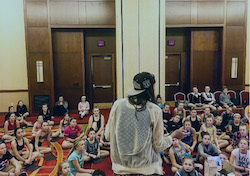
Leslie Scott at an expo. Photo courtesy of YPAD.
As part of a new series seeking to address some of the harder questions affecting the dance industry, Dance Informa has teamed up with dance educator Leslie Scott’s non-profit organization Youth Protection Advocates in Dance (YPAD). On this opening inquiry into the idea of dancing sexy, YPAD’s Advisory Panel and global community of members had many thoughts to share.
Defining Sexualized Dance
Before we can consider the consequences of hyper-sexualization from various perspectives, it’s worth taking a moment to define what it is with an expert like Dr. Tomi-Ann Roberts.
Roberts, PhD, is professor and chair of the Psychology Department at Colorado College. Her research focuses on the psychological consequences of the sexualization and objectification of girls and women.
Roberts tells Dance Informa, “Sexualized dance puts the dancer in a unique ‘relationship’ to the audience. Rather than the dancer being absorbed in the ‘storyline’ of a dance, she/he is displaying the body and movements of the body to the audience in such a way that the audience is compelled to view the movements as an invitation to sexuality.”
Roberts explains that this “invitation to sexuality” is accomplished by a number of things, listing: “the movements themselves, the music lyrics, but especially by the dancer engaging in a kind of eye contact with the viewer that does not vary. It says, ‘I see you seeing me move my body in a sexual way.’”
From A Psychologist’s Perspective
Roberts explains what her research and experience with sexualized dance have taught her: “The problem is that this objectifies the dancer’s body. The movements and the body are now separated out from the person, the dancer. When we objectify another human being, we treat them like a thing, or a tool for our own gain, as opposed to a human being with the capacity for independent action and their own decision-making.”
She continues, “When studios and conventions make money off children’s sexualized dancing, when the audience claps the loudest for such dances, or when YouTube videos of children rehearsing or performing highly sexualized dances garner the most views and likes, then these children’s bodies are being used.”
When specifically asked what the consequences are for children and youth who are treated this way, Roberts says that they come to “self-objectify, or to internalize a view on their own bodies that is from an outsider’s perspective.”
She expounds, “They come to feel that their bodies are not their own but rather ‘belong’ to others. This can make them more susceptible to harm. Children can begin to view themselves as objects, only appreciated and valued for their sexy appearance, as opposed to their competence, training and skill.”
Also concerning was what adults viewing these dance moves experience. She said studies show that they begin to “unconsciously associate childhood with sexuality”, and also to view sexualized children as “less competent, and less deserving of our moral concern.”
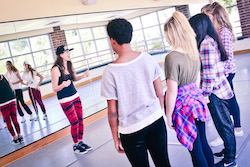
Youth Protection Advocates in Dance. Photo courtesy of YPAD.
In conclusion, Roberts voices, “When expressions of sexuality are one-directional, as is the case in dance performance (designed for a viewer or judge to look at and evaluate) then the ‘expression’ of sexuality is not mutual or consensual. The expression is solely for other people’s enjoyment. When very young children ‘perform’ sexuality this way, then they are learning that their bodies belong in a sense to others, not to themselves. In contrast, healthy sexuality is about consent, mutual enjoyment, and self-exploration.”
From A Teacher’s Perspective
Longtime teacher, judge and dancer Kaelyn Gray shares that she once thought age-appropriateness was truly a matter of opinion.
She shares, “My work at the time was teetering on that thin line, and I took complete offense the first time a studio owner complained about a routine of mine at a competition. I was so upset that my ‘freedom of art’ was being deemed inappropriate, and chalked it up that the woman was very conservative. I had zero education about the short- and long-term effects of music and movement, the cognitive changes that take place, the connection of body image/esteem in regards to costuming… I was simply uneducated. And I always say, ‘How can you know what you don’t know?!’”
Reflecting back to this time, Gray continues, “My 20-something ego was being stroked when the dancers were emulating me, as a woman exploring my healthy sexuality, and never thinking of them. How did they feel doing my movement? Were they uncomfortable? Did they understand the lyrics? Did they even connect to the story? How could they…they were teenagers! It was very much about me, and proving myself, and not digging deep into the layers of what true connection is to your mind/body/soul when one dances.”
She adds, “Fast forward a decade – wow. We are living in different times. Music is 99 percent about sex, treating women like objects, glorifying drugs and alcohol, et cetera. Combine that with an insatiable appetite our youth has for social media, videos, YouTube, Instagram, and that is a recipe for an epidemic that is happening right now. It breaks my heart to see these young, impressionable dancers emulating material that is obviously meant for adults, taping it and slapping it on YouTube or Twitter for all to see.”
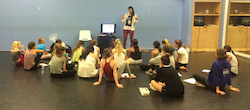
Leslie Scott leading YPAD. Photo courtesy of YPAD.
Her awakening to the issue of hyper-sexualization and even sexual abuse in the dance industry eventually led her to YPAD. Now a YPAD Advisory Panel Member, Gray says, “I was pulled into YPAD with such a force that I knew that part of my purpose in life was to help make a difference in keeping kids safe and healthy in the dance industry.”
She continues, “Through much research from our incredible panel of educators and psychologists, I was truly enlightened about the real dangers we are placing our kids in when we are not responsible with our choreography, music and costuming. I like facts, I’m a fact-driven advocate, and when the statistics were staring at me right in the face, there was no question. We have a growing, dangerous epidemic happening, and we as educators need the education, need this organization and need to put our egos away for a second and just listen… Simply stated, when you are in the business of children, freedom of ‘art’ takes a back seat.”
From A Judge’s Perspective
Known as a vivacious performer, teacher and choreographer, Dana Wilson is also a judge for some major dance competitions. On this issue of hyper-sexualization, she is no newbie, admitting, “The first time I experienced sexualization imposed on dancers, I was the dancer it was imposed on.”
Wilson shares, “I grew up a competition kid, and I remember dancing scantily clad to songs like ‘Hot Thing’ by Prince and ‘Maybe’ by Toni Braxton. I remember thinking, ‘Wow, this is it! I am really grown up now! I get to do these sexy dances like the older girls!’ I loved it, replicated the idea of ‘sexy’ to the best of my ability.”
Wilson explains, however, that from her perspective, the issue with sexualization today is not so much a matter of mental or emotional health but instead of privacy and safety. In her opinion, the real issue is with young dancers publicly posting suggestive content online.
She honestly shares, “Now that I am all grown up, I consider myself a well-adjusted adult with a healthy relationship to my sexuality. I cannot say that any subjectively inappropriate choreography, song or costume that was imposed had an unhealthy effect on my life. I can say, with the increase in popularity of YouTube and other social platforms, young people are out there dancing to songs like ‘Hot Thing’ or ‘Maybe’ (or ‘I Don’t Give a F*ck’ by Nicki Minaj), owning it, commanding the attention… and their proof is on the internet for all to see (and praise or criticize). Whether I am watching Ellen or flipping through my Instagram feed, I see young dancers doing mature and suggestive movement to equally suggestive pop songs. Our industry may not be less healthy than it was when I was growing up, but on the subject of privacy alone, I do consider it to be less safe.”
As for judging routines at competition, Wilson says, “If I find that the dancers’ intention, the music choice and the costume are inappropriate, then I will remove points. That sort of three-strike system will affect the score, but I really like to keep the dancers’ skill the key point of our evaluation.”
When asked how conventions and competitions could start to further promote age appropriateness, Wilson says it’s a tough and sensitive issue.

Photo courtesy of YPAD.
“It would be so simple if dance educators and adjudicators could establish a collective and objective rubric for what is ‘appropriate’, but dance is a subjective art form and even the word ‘appropriate’ is subjective, so that won’t be so simple,” Wilson elaborates. “My best suggestion is that we encourage healthy and age-appropriate material not just by rewarding the young dancers for doing it but by creating and rewarding work that is appealing to all ages, as adults! When I was a kid, I wanted to ‘dance sexy’ because that’s what the older girls did, and I think that is natural. Perhaps if we (the older girls) present an alternative, that would be what our young dancers aspire to.”
Moving forward, Wilson hopes dance competitions and conventions will continue to take the issue of sexualization seriously. She concludes, “I would love to see a system that rewards good natured and bright intention behind movement.”
From A Male Hip-Hop Dancer’s Perspective
B-boy and studio owner Ray Owens is on YPAD’s Board of Directors. Having also been a middle school teacher for 18 years, he is highly experienced with teens and youth culture. He’s passionate about the issue of hyper-sexualization and believes its negative impact is “infinite”.
Owens tells Dance Informa, “Sexualized dance first begins with the music. Suggestive lyrics often lead to sexualized movement. This manifests itself in not only objectifying choreography, but also dominating or submissive character portrayal. This type of dance is not limited to only objectifying the female dancer but also the male.”
On why he thinks this is a big deal, he says, “Every individual will react differently due to many factors such as parental guidance, self esteem, body image and societal sex role, to name a few. It will ultimately lead to associating self-fulfillment with mastering over sexualized movement. What gets the most attention in social media? Television? Movies? In school? In dance class? On stage? And eventually, in the industry? Regardless of age, sex or gender, the sexy character, which requires minimal dance training, technique or musicality, get the most attention, ‘likes’, applause and ultimately, money. I have seen this result in eating disorders, body dysmorphia and depression. Increasingly, this type of movement has had a negative impact in my dancers that compete.”
He continues, “Dancers are athletes and train as such, and therefore, as they perceive ‘sexiness’ as a style or technique, their competitive nature as an athlete drives them to win – to be the best. Often winning or being the best means enhancing sexual movement, rather than foundational movement. Then the sexiness is validated when the over-sexualized routine that lacks true artistic value and dance technique wins top places in dance competition.”
How does Owens combat this with his dancers? Simple: “I train my dancers to never sacrifice art over the artificial.”
When asked how he tries to influence others to prevent unhealthy sexualization, he answers that’s all about in-person engagement and education. He also says as a studio owner, one must be mindful of the issues and then “must develop a team that reinforces the message and experience.”
Finally, From Another Psychologist’s Perspective
Perhaps the most common reasoning when supporting “sexy” dance for young dancers, especially teen dancers, is that it’s a natural extension of them exploring their sensuality. On this, veteran adolescent psychologist, former dancer and influential YPAD Advisory Panel Member/Certification Contributor Dr. Christina Donaldson weighs in. She immediately differentiates between hyper-sexualization and the self-expression of sexuality.
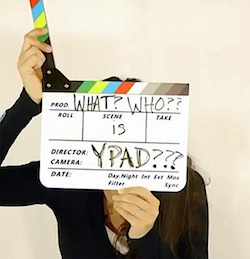
Photo courtesy of YPAD.
“Sexualization in dance hinders the adolescent in his/her own self-discovery of their sexual identity because the sexual identity is superimposed upon them,” she explains. “In a sense, their sexual identity is mandated instead of self-discovered. The difference between sexualized dancing versus self-exploration is where the notion of sexual identity originates. In sexualized dancing, it is oftentimes imposed upon them by an authority figure (e.g. a dance teacher or a dance judge in competitions) unlike self-exploration where adolescents draw upon their own notions.”
She continues, “When adolescents dance in a sexualized manner, they learn they are sexual beings and get attention for their ability to perform those dance pieces, which then becomes attached to their identity and self-concept. The more attention they get in dancing in that manner, the more they will continue engaging in that behavior. As they get older, they begin to see themselves and their body as objects and do not have an embodied sense of identity. This results in an imbalance in the development of identity. They are drawn to the attention they receive, images they see, and begin to make associations as to who they need to be in order to be accepted and that drives the development of an identity more so than their own inner world of self-discovery.”
Dr. Donaldson warns of the dangerous repercussions of this – recalling her work with dancers, athletes and models who had to later seek treatment for eating disorders, anxiety, depression, obsession-compulsion, relationship issues and other mental health disorders. “The underlining theme in working with these individuals is helping them get out of the perfectionistic, externally driven sense of self that was imposed upon them, and assist them to discover their own sense of being,” she says. “Most of the time, their sexual identity is non-existent and they fear developing it for they had already received too much attention of their bodies being objects that they don’t know how to be in their body. Their sense of identity becomes the body (what it looks like, what it does) and they go to great lengths to try and control their bodies for that is their only sense of identity. The therapeutic work we end up doing is teaching them that being in their bodies are safe and help them to develop their inner world of identity and self-concept.”
She strongly urges that the dance industry fight sexualization and instead encourage healthy self-discovery – for the good of all involved. While she offers a plethora of advice, her first and main recommendation is to simply be more aware.
“Be aware of what story you are communicating to your dancers as well as what stories your dancers are communicating to the audience,” she concludes. “Pay attention to what you are reinforcing.”
Learn more about YPAD and its new campaign #AgeAppropriateIsNoLongerVague at www.ypad4change.org.
By Chelsea Thomas of Dance Informa.


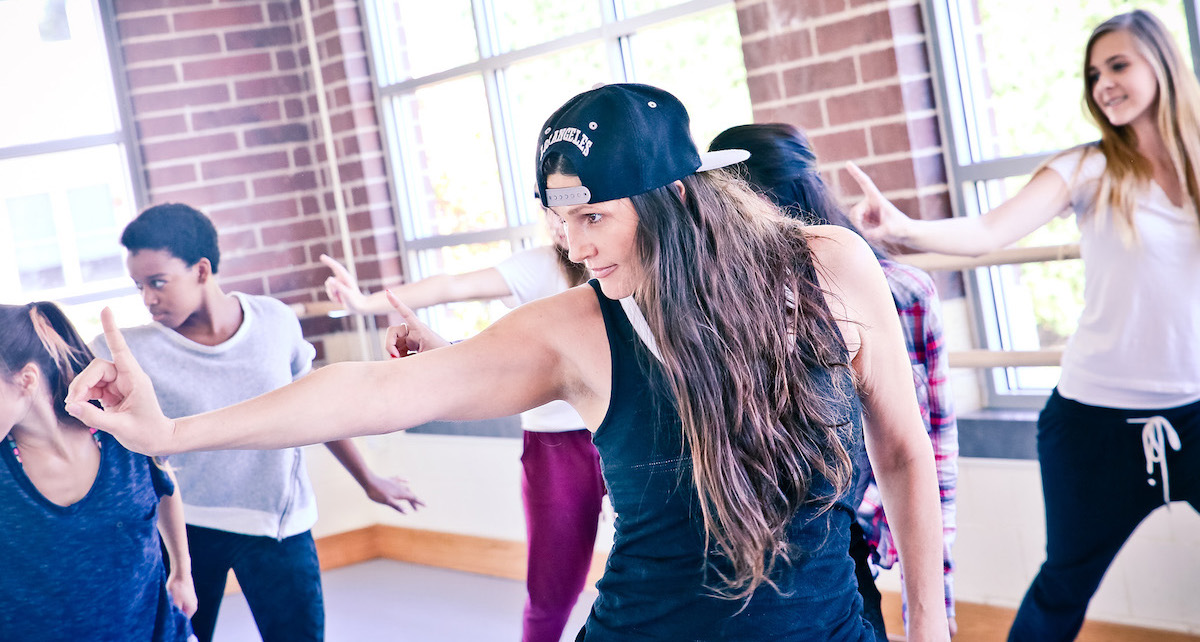



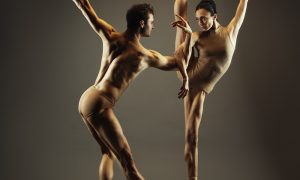









Pingback: What's wrong with dancing 'sexy'? - YPAD